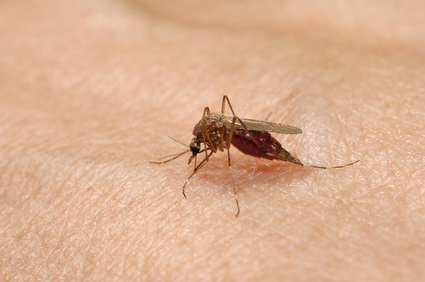A surface protein used by the malaria parasite to invade blood cells would seem an attractive vaccine target. In fact, the protein—apical membrane antigen-1 (AMA1)—has already been used in a vaccine tested in humans. The vaccine, however, proved effective against just one particular strain of the parasite Plasmodium falciparum. The AMA1 surface protein, like the malaria parasite in general, exists in multiple strains. Simply put, AMA1 defeated the vaccine by virtue of its antigenic diversity.
Hoping to devise a broadly protective vaccine that would still target AMA1, scientists at the Walter Reed Army Institute of Research tested different cocktails of AMA1 from different parasite strains. They confirmed that a cocktail of AMA1 proteins from three different parasite strains was better than one or two, and one they call Quadvax, which contained AMA1 proteins derived from four different strains, led to an antibody response that was broader than the sum of strain-specific antibodies elicited by the four individual strains.
That Quadvax delivered a kind of mixed-allele immunogenicity bonus was especially interesting. According to the Walter Reed scientists, this finding “supports the further development of multivalent AMA1 vaccines because broad antigenic coverage is achieved not only by expanded antigenic footprint of strain-specific antibodies but by inducing higher levels of antibodies against conserved inhibitory epitopes.”
Besides varying a lot from strain to strain, AMA1 also contains conserved regions on exposed parts on its surface. The researchers found that vaccination with Quadvax yielded not only antibodies against the variable surface regions, or epitopes, but also against more conserved epitopes of the AMA1 protein. Such antibodies were not seen when using individual strains for immunization, but Quadvax appeared to enhance the immunogenicity—the ability to provoke an antibody response—of these conserved parts of the protein. Since the epitopes are identical across strains, the resulting antibodies are broadly active rather than strain-specific.
The scientists, led by Walter Reed’s Sheetij Dutta, published their results December 26 in PLOS Pathogens, in an article entitled “Overcoming Antigenic Diversity by Enhancing the Immunogenicity of Conserved Epitopes on the Malaria Vaccine Candidate Apical Membrane Antigen-1.” In this article, the scientists described their solution to the AMA1 diversity problem: “Antibodies against a mixture of only four naturally occurring AMA1 allelic proteins ‘Quadvax’ inhibited invasion of red blood cells by a diverse panel of malaria parasites that represented the global diversity of AMA1 in the field.”
The authors also described how Quadvax-elicited antibodies inhibited a range of parasites, including many strains that were different from those in the Quadvax mix. In different laboratory tests, Quadvax-induced antibodies inhibited the growth of 26 different parasite strains, said the scientists, who added that “the combination of four AMA1 variants in Quadvax may be sufficient to overcome global AMA1 diversity.”
“We had set out to study broadening of antibody responses achieved by mixing AMA1 proteins and were surprised and delighted to find not only greater variety of strain-specific antibodies but also increased antibodies against conserved epitopes were induced by the Quadvax,” commented the scientists. “Perhaps even more exciting, when mixed, combinations of these antibodies were synergistic in their broad inhibition of many parasite strains.”
The authors concluded by expressing optimism that a successful vaccine would not need to be frequently reformulated. Also, they wrote, “It is assuring that a major mechanism of broadened inhibition involves refocusing antibody responses toward regions that are structurally conserved. In future, human-use formulations of QV need to be evaluated in primate models and in a human blood-stage challenge model.”


